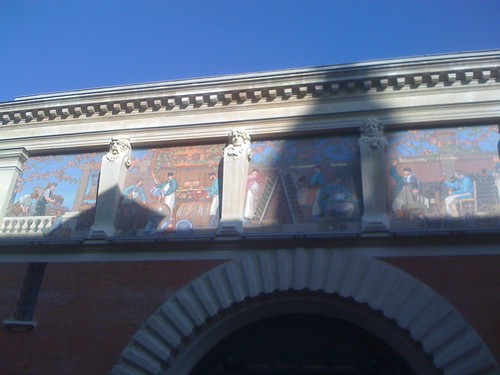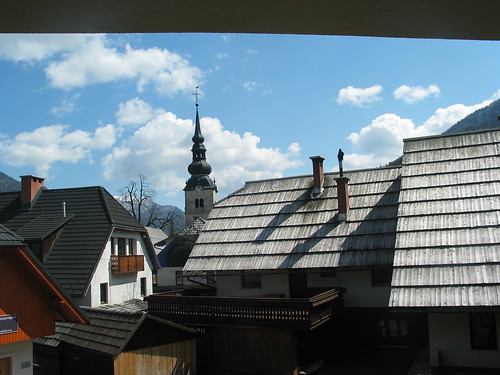Dehbia, Evelyn and I adapted and elaborated the Walls Talking Poster idea into what is to become a 2 month eTwinning project.
The idea is that students describe what really matters in life using a combination of images and texts and share and compare class production.
Tools to be used are:
Twinspace user walls, Twinspace and/or class blog, Twinspace forum, SP Studio, Big Huge Labs, others.
Aims:
Connect with a partner from another country and collaboratively explore each other's culture and view of life.
Reflect about things that matter and share and compare class production.
Work process:
Step 1 : Introduction (creating avatars & editing Twinspace profiles)
Step 2 : Choosing partners and connecting with them.
Step 3 : Creating an image/text combination about something that matters to you
Step 4 : Checking production, commenting and voting for the best three posters.
Expected results:
A collection of posters displayed in the schools or on the web.
Monday, October 18, 2010
Sunday, October 17, 2010
eTwinning in France
From the 13 to 15 October I was a lucky participant of the Hungarian-French-Slovene eTwinning PD Workshop. It took place in the lovely French town of Reims in the land of Champagne.

The workshops included:
• Getting familiar with the project work basics,
• Examples of good practice,
• Getting familiar with the eTwinning portal and Elluminate,
• Networking, creating projects and registering partnerships.
One of the examples of good practice came from Slovenia – Tatjana Gulič from the Preska primary school wowed the audience with a 'Your Tube' project idea linking music and physics classes in two Slovene schools – a primary and a secondary one. The project idea was developed in collaboration with Lorena Mihelač, a music teacher from the Metlika secondary school.
The main idea is exploration of scrap tubes from various materials – during the physics classes students study them from the point of view of physics and during the music classes they write and play music using them.
Participants tried out the 'tubes' – it was a lot of fun and sure worked!
Inspired by great examples we rolled up our sleeves, exchanged our project ideas and started connecting. We registered a number of new eTwinning projects which should connect Slovene, Hungarian and French students and teachers in the current year.
Such eTwinning seminars are a wonderful experience – I'd say especially for teachers who already have some experience with collaborative project work and are interesting in finding an international partner.
I presented the Things that matter idea from the Walls Talking project and was then approached by two lovely teachers from Reims, Evelyne and Dehbia, with whom we developed an eTwinning project idea and registered it on site. I’ll post about our activities on the class blog.
Lots of interesting happens behind the walls of out schools – it's nice to be able to see and learn about these things – and get inspired dip our toes. All you need to do to attend such a workshop is check out the national agency’s site in your country – in Slovenia it's Cmepius.

The workshops included:
• Getting familiar with the project work basics,
• Examples of good practice,
• Getting familiar with the eTwinning portal and Elluminate,
• Networking, creating projects and registering partnerships.
One of the examples of good practice came from Slovenia – Tatjana Gulič from the Preska primary school wowed the audience with a 'Your Tube' project idea linking music and physics classes in two Slovene schools – a primary and a secondary one. The project idea was developed in collaboration with Lorena Mihelač, a music teacher from the Metlika secondary school.
The main idea is exploration of scrap tubes from various materials – during the physics classes students study them from the point of view of physics and during the music classes they write and play music using them.
Participants tried out the 'tubes' – it was a lot of fun and sure worked!
Inspired by great examples we rolled up our sleeves, exchanged our project ideas and started connecting. We registered a number of new eTwinning projects which should connect Slovene, Hungarian and French students and teachers in the current year.
Such eTwinning seminars are a wonderful experience – I'd say especially for teachers who already have some experience with collaborative project work and are interesting in finding an international partner.
I presented the Things that matter idea from the Walls Talking project and was then approached by two lovely teachers from Reims, Evelyne and Dehbia, with whom we developed an eTwinning project idea and registered it on site. I’ll post about our activities on the class blog.
Lots of interesting happens behind the walls of out schools – it's nice to be able to see and learn about these things – and get inspired dip our toes. All you need to do to attend such a workshop is check out the national agency’s site in your country – in Slovenia it's Cmepius.
Friday, May 14, 2010
Exploring slideshow options

Many interesting photo and comment contributions have been pooled within the Walls Talking project. On the project site and in the Flickr group. The flickr group pool contains is a complete collection of photos gathered so far.
I was wondering about the simplest way of displaying thematically related photos with pertaining info and comments... The only way to do some of this in Flickr (photo + info slideshow) seems to be to tag items in the pool and then share the tag-generated slideshow. Or am I missing something?
I've gathered some of the sets here and here.
Flickr slideshows look good and have this great embed function, but to see photo related info viewer needs to watch them full page with the 'show info' option on.
So I was wondering about how to display things by showing more information about contributions more interactively and I remembered diigo slideshows I once played a bit with and liked a lot.
This is my attempt number 1 - a longer Listen to the Walls Talking diigo slideshow covering more or less the same topics as the above Flickr sets. The default transition speed is rather slow, but you can always use the buttons below to move on faster or speed it up bottom right.
I like diigo a lot. Miss an embed function but appreciate a lot the fact that the slideshow is interactive and can include any webpage.
Monday, May 10, 2010
Why do I blog?

Jen asked why do we blog in the Webheads YG. This was my reply.
I don't blog much and faaar from regularly but enjoy it a lot - and also enjoy going back to what I've done.
My blogs are my online spaces where I occasionally retreat to reflect, record, share, or simply keep things I care about. I've got a cyberkitchen, a cybermill, a cybergarden and a cyberattic. Even though the first two are a bit more alive than the others I don't think I'll ever pronounce dead any of them.
I like the way conversation is kept open this way and people can get in touch with you. I am not a well organized person by nature so I also like a lot the way contents on blogs can be simply and meaningfully organized using tags. It comes handy when you need to show sbd. what you are working on, or what you've done/planned to do at some point, and to aggregate contents from various sources.
I like the way you can feel the writers behind their blogs, easy follow numerous blogs using an aggregator of some sort, and learn so much and meet so many fascinating people that it's incredible.
Thursday, May 06, 2010
Online safety basics
Just sharing here a presentation I created for collaborative online learning group led by Viljenka Šavli within the national project called e-Šolstvo, which promotes e-empowerment in schools across Slovenia. It's in Slovene.
Varnost na spletu
View more presentations from sasasirk.
Labels:
copyright,
online_safety,
presentation,
sdutsj,
webheadsinaction
Wednesday, May 05, 2010
Garbage related sites that make you think

Another English version of my post from the Smeti Ning.
Plastic bags are one of the first things that comes to my mind in connection with garbage.
1. Battle of the bags is an interesting American documentary comparing the use of plastic and paper bags – which are more damaging for the environment? What has been done so far in various places to fight unnecessary pollution, what we can do ourselves... The documentary is split into short 1-2minute chapters, is partlčy interactive and I find it useful for English listening comprehension (B1+) as well as a good starting point for a simple research into our bag policy.
2. The Battle of the Bag – is about 40 minute long Canadian documantary about plastic bags.. lots of interesting facts – production, history, issues, responses, ...
3. Series of shocking photos of dead birds from a remote Pacific island away from civilization – their rottening dead bodies are full of plastic garbage from the ocean. The island is 2000 miles from the closest continent.
4. http://explorethecycle.com/ is a nice, animated visualisation of the recycling process at a materials recovery facility – an easy to follow animation consisting of short chapters
Tuesday, May 04, 2010
Our garbage - our concern

This is an English version of a post I've written in Slovene at the Ning site called Smeti, naše skrbi (Our garbage, our concern). The site has recently been created by my friend Vili (and will, sadly, need to be relocated due to Ning's new business policy).
The idea behind the site is to promote class collaboration around the topic of garbage - within and between schools and cultures. Teachers have been encouraged to post their project ideas to the Ning and I've posted this one:
DIY sites: practice English + learn about cool recycling ideas + connect with others
At http://www.instructables.com/ one can find numerous DIY ideas concerning recycling various materials. So why not directing students over to this site – they'll easily find there interesting and feasible ideas to carry out in practice – cross-curricularly within their school or reeaching out to other national or international partners in crime.
Interesting ideas could for example be gathered together at an English class and if necessary translated. Individually or within some practically oriented courses students could then create things and maybe organize an exhibition, an auction, or find some other meaningful or useful place for them (e.g. Biotechnical school students creating a scarecrow out of old CDs and setting it up on their school field...)
Older students could perhaps gather together interesting project ideas during their English class and pass them on for younger groups to create them... (Suzana and I have been thinking along these lines during one of teacher training sessions – she teaches young learners in primary school, I teach college students).
With this idea in mind I went to the before mentioned website and checked out some possible ways of recycling paper. I was amazed by numerous ideas there and by simplicity of this one here http://www.instructables.com/id/How-to-Make-Paper-Beads/ - so I emptied my paper basket bin and used the paper and wooden beads to create this:
Here's a longish list of various DIY sites ... Worth checking out, I think.
Also worth checking out is http://earthcast.posterous.com/ - a great collection of nice green project ideas for teachers and students.
Copyright and right to copy

Image created using Bart Simpson Chalkboard Generator
It's been 300 years since the world’s first copyright law was passed by the English Parliament as ‘An Act for the Encouragement of Learning’. The British Council gathered ideas about copyright from renown thinkers of our time and posted them here.
I like Cory Doctorow's defense of our right to copy.
"We are that which copies. Three or four billion years ago, by some process that we don't understand, molecules began to copy themselves. We are the distant descendants of those early copyists - copying is in our genes. We have a word for things that don't copy: 'dead'."
A must see presentation on this topic from 2002 is Lawrence Lessig's free culture.
Labels:
copyright,
free_culture,
lessig,
simpsons,
webheadsinaction
Thursday, April 22, 2010
Copyright at SIRIKT2010
I attended this year's Sirikt conference and participated in a round table discussion on copyright in Slovenian education together with renowned Slovene copyright lawyer experts Miha Trampuž, Mojca Pečar and Katarina Krapež.
I did a bit of thinking and reading on this topic in preparation for this event and saw that the more I read the more questions I ended up with... It's true, educators, kids and web folks in general often don't remember to credit authors, cite sources, and ask permissions for publishing things online... I think mostly unintentionally, because we tend to do things fast these days and do them the way we see others do them.
My schoolmate at secondary school had this fabulous T-shirt saying 'no school, no job, no problem' - if you can't tell right from wrong you are blissfully unaware of mistakes you make... it was sort of along these lines that my thoughts rambled as I was trying to make sense of the copyright act restrictions.
As I said, the more I read the more questions I had… Many of them were kindly answered during the round table discussion and earlier workshop given by Katarina, still many remain unclear.
There are no national borders on the web… which is just great. I understand I need to follow Slovene copyright law in Slovenia – also when I use foreign copyrighted works? E.g. I think that according to the Slovene law I could freely use copyrighted music in a non-commercial school performance as long as I credited the authors and cited my source… I’m not sure I could use e.g. American copyrighted music the same way here…
Theory and practice are a challenge to match if you are not a lawyer.
Katarina, a cc advocate, mentioned that people sometimes surprisingly know more about cc than about the copyright law. I don't find that too surprising since cc terms are written way more humanely and are a much appreciated successful attempt to reconcile the legalese with the language understood to common web folks. I'm a big fan of the 'for dummies' trend and think we should all create meaningful contents for our target users (teachers too ;-)) if we expect them to take it seriously.
Here's a lovely view I from my hotel window:

I did a bit of thinking and reading on this topic in preparation for this event and saw that the more I read the more questions I ended up with... It's true, educators, kids and web folks in general often don't remember to credit authors, cite sources, and ask permissions for publishing things online... I think mostly unintentionally, because we tend to do things fast these days and do them the way we see others do them.
My schoolmate at secondary school had this fabulous T-shirt saying 'no school, no job, no problem' - if you can't tell right from wrong you are blissfully unaware of mistakes you make... it was sort of along these lines that my thoughts rambled as I was trying to make sense of the copyright act restrictions.
As I said, the more I read the more questions I had… Many of them were kindly answered during the round table discussion and earlier workshop given by Katarina, still many remain unclear.
There are no national borders on the web… which is just great. I understand I need to follow Slovene copyright law in Slovenia – also when I use foreign copyrighted works? E.g. I think that according to the Slovene law I could freely use copyrighted music in a non-commercial school performance as long as I credited the authors and cited my source… I’m not sure I could use e.g. American copyrighted music the same way here…
Theory and practice are a challenge to match if you are not a lawyer.
Katarina, a cc advocate, mentioned that people sometimes surprisingly know more about cc than about the copyright law. I don't find that too surprising since cc terms are written way more humanely and are a much appreciated successful attempt to reconcile the legalese with the language understood to common web folks. I'm a big fan of the 'for dummies' trend and think we should all create meaningful contents for our target users (teachers too ;-)) if we expect them to take it seriously.
Here's a lovely view I from my hotel window:

Subscribe to:
Posts (Atom)
